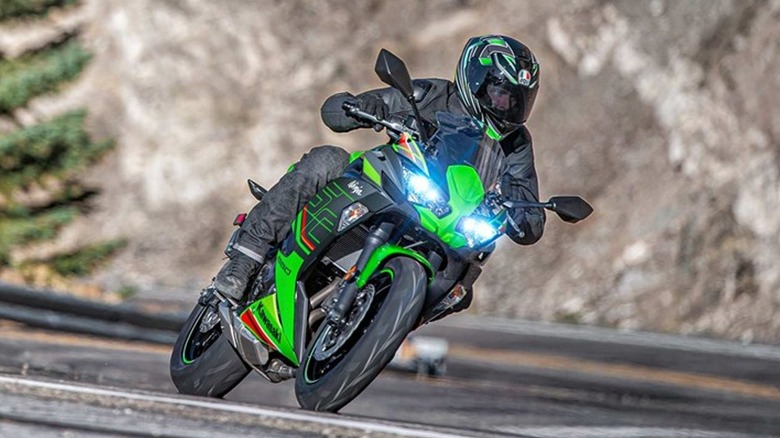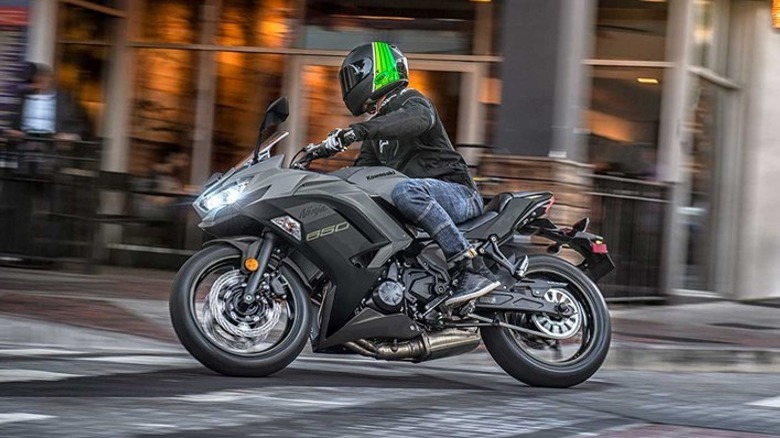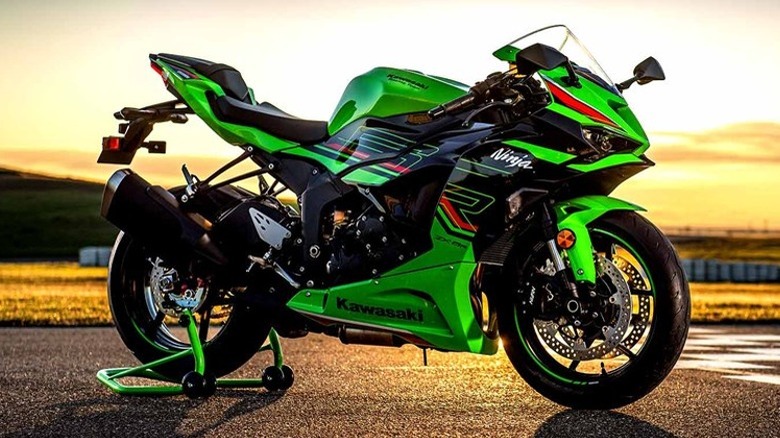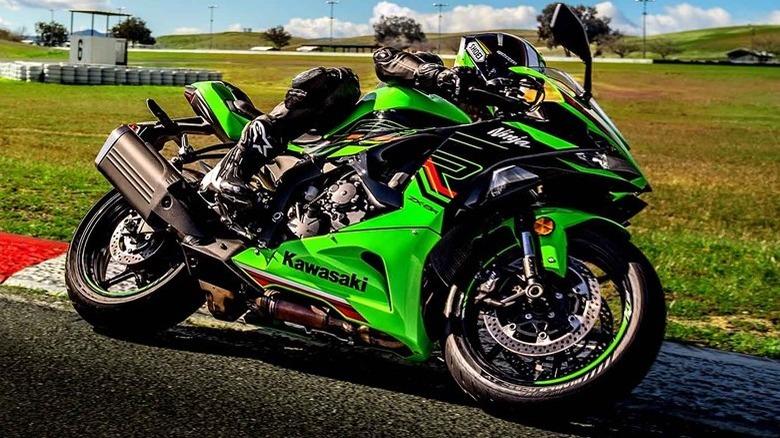Biggest Differences Between The Kawasaki Ninja 650 & Ninja ZX-6R Motorcycles
If you're looking for a good midsized sport bike then Kawasaki's Ninja is definitely one of the more prominent model-lines that you're going to encounter. Alongside other major motorcycle manufacturers like Honda and Yamaha, Kawasaki is one of the best-selling Japanese motorcycle manufacturers in the U.S.
Those who are looking at picking up one of Kawasaki's bikes might be a little confused by the company's naming conventions, though. Nearly all of the company's sports bikes are part of the Ninja line, but Kawasaki doesn't simply delineate bikes in that line by engine size like most other companies. Secondary designations are used to classify the three different sports bike sub-categories that the company currently produces: Sport, SuperSport, and HyperSport.
The Ninja 650 falls into the Sport category. It offers a consumer-grade riding experience that is more than sufficient for street riding. This 650 is also considered one of the most reliable motorcycles Kawasaki ever built. The Ninja ZX-6R, on the other hand, is considered part of the SuperSport sub-line. This means that it's made to perform well on streets while also being able to take things up a notch for weekends on the racetrack. But what exactly does all of that mean in terms of the difference in engine design, features, and price? Here is a quick breakdown of the real differences between the Ninja 650 and the Ninja ZX-6R.
Similar-sized engines with different performance
The engines used by the Ninja 650 and the Ninja ZX-6R are very similar in size. This is part of the reason why so many riders are confused about the difference between them. The Ninja 650 has a 649 cc, DOHC, parallel-twin 4-stroke, 8-valve engine. It has an 83.0mm bore, a 60.0mm stroke, and a 10.8:1 compression ratio. It also has a liquid cooling system and a 6-speed transmission. All of this adds up to a bike that Cycle World reports achieves "68 peak horsepower at 8,000 rpm and 47.2 lb-ft of torque at 6,750 rpm."
As for the ZX-6R, this bike has a 636 cc engine, but don't let its marginally smaller size fool you. It's a DOHC, in-line 4-stroke, 16-valve motor with a 67.0mm bore, a 45.1mm stroke, and a 12.9:1 compression ratio. Like the 650's engine, it's liquid-cooled and has a 6-speed transmission. That's about where the similarities end, though. This engine is significantly more powerful. Cycle World reports that it can reach 108.4 horsepower at 13,200 rpm and 45.8 lb-ft of torque at 10,900 rpm. This means that even though these two bikes are of a similar size and weight, and they are both fast Kawasaki motorcycles designed for seasoned riders, the ZX-6R's engine provides a big boost in both maximum speed and acceleration.
There are a few distinct design and technological differences
The Ninja 650 and Ninja ZX-6R look pretty similar at a glance. They're both sports bikes and are covered in fairings that have the sharp, angular designs that motorcycle enthusiasts have come to expect from Kawasaki. Even the bikes' dimensions are similar. The 650 is 80.9" in length, 29.1" in width, and weighs 423.4 lbs. while the ZX-6R is 79.7" long, 28.0" wide, and weighs 432 lbs. But on closer inspection, you'll notice a few subtle, but distinct differences in their design. The 650 is more squat and solid in appearance, while the ZX-6R looks more lean and cut back.
The ZX-6R also has a few extra technologies at its disposal. Both bikes share Kawasaki's assist and slipper clutch, dual throttle valves, economical riding indicator, proprietary traction control, and both come with the option for anti-lock breaks. But the ZX-6R has three distinct technologies that the 650 doesn't.
It comes with Kawasaki's specialized quick shifter, which allows you to upshift clutchlessly with a fully open throttle. It has power modes to make it easy for riders to switch between track and street riding experiences. According to Kawasaki, these "offer riders an easily selectable choice of engine power delivery to suit riding conditions or preference." The ZX-6R also has smartphone connectivity and works with the Ridology App to track your bike's odometer, fuel gauge, and maintenance schedule as well as create riding logs. This also allows the bike to display telephone notifications on the digital instrument panel.
The SuperSport is a bit more expensive
There are several Kawasaki motorcycles that are considered quite affordable. It's one of the many reasons that Ninjas are often considered to be among the best sports bikes for beginner riders. The 650 definitely falls in line with this, but the extra power and gear that you get from the ZX-6R doesn't come without a cost.
The brand new 2024 Ninja 650 starts at $8,299 for the standard model and $8,899 for the ABS version. This is a more than reasonable price for a mid-sized motorcycle. It's cheaper than the 2023 Honda CBR650R which goes for $9,899 and several other, similar bikes, making it an excellent value option for those looking for a bike in this size category.
The ZX-6R is a bit more pricey. The standard model starts at $11,399 and the ABS version goes for $12,399. This means you'll be paying about 30% more for the SuperSport. To be fair, this is in line with pricing models with competitors, and it's still a bit cheaper than other performance motorcycles. The 2024 Honda CBR600RR is a smaller motorcycle (with just a 599 cc engine) and yet, it costs $12,199. With this in mind, the Kawasaki ZX-6R seems much more reasonable — if still not entirely economical.



